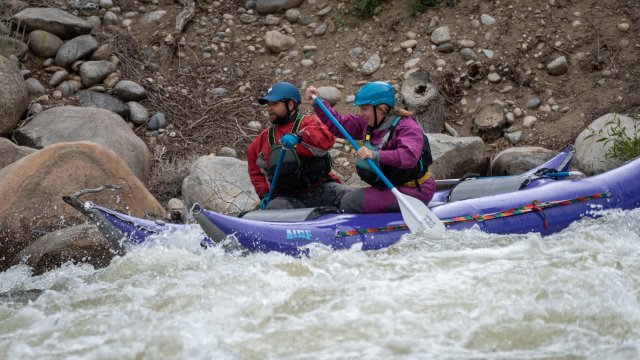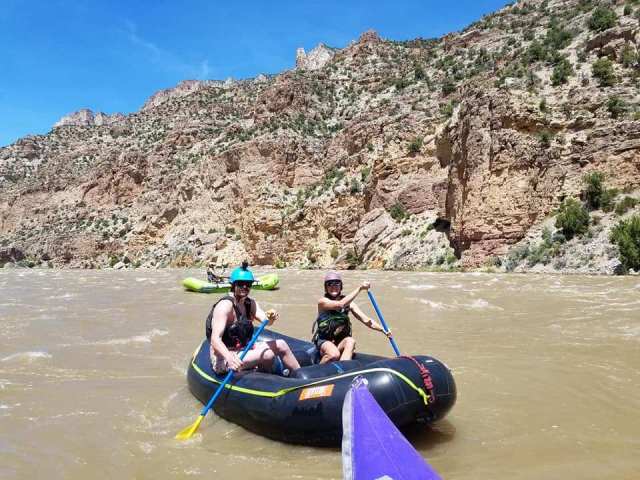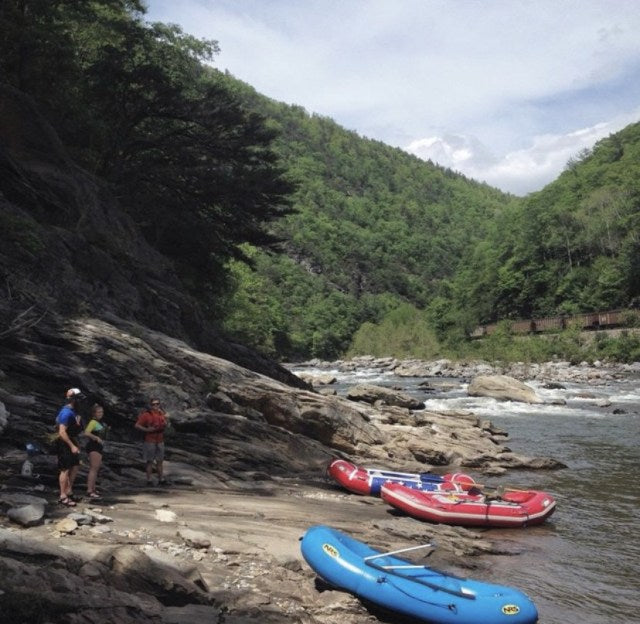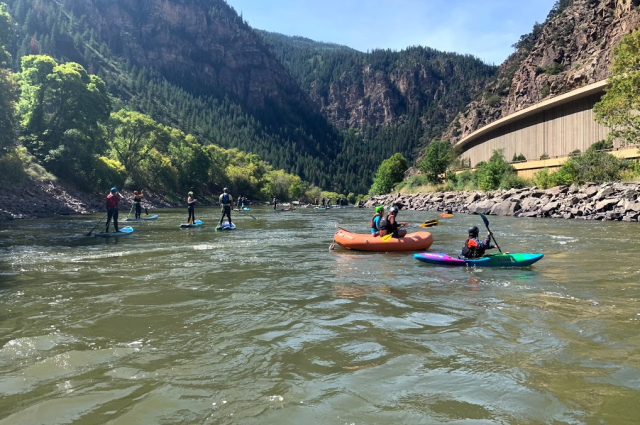Tips for Rafting with Two People (R2)
Paddling a boat by yourself is really fun, but the old adage “two is better than one” isn’t lost on us! R2 rafting (rafting with two people) is the most fun you will ever have in a raft but it has a lot of nuances that need attention. Our resident Gear Expert and R2 dream partner has some tips for rafting with two people.
A good rafting partner is like a good marriage partner: You must be patient and have awesome communication.
R2 rafting will test both of these skills, sometimes, but it’s so worth it.
So, how do you teach someone to load up and take the seat beside you in a raft? Below are some tips to help you navigate the waters!

While paddling R2, you both are the guide and the power, which results in far less room for mistakes.
With a standard paddle crew, there is a division of responsibility; the paddle crew builds up speed while the guide is responsible for steering and teeing up accordingly. In a crew, one person throwing a poorly-timed stroke won’t place you off your line but that’s not the case with R2.
Getting the Stroke Right
When R2’ing, generating forward speed while holding the angle to maintain your line can be challenging but is necessary and requires simultaneous steering and power strokes.
If you don’t use the river to your advantage and only make adjustments as needed, you’ll end up doing a lot more work than you should.
It sounds easy enough until you realize that two people will always paddle differently based on height, arm span, strength, and experience. It’s rare that two people R2’ing provide the same amount of power with each stroke.
As such, you’re going to kick the boat all over the place with uneven strokes if you and your partner don’t have a lot of experience together.

When R2 rafting, it’s best to try to match the average stroke power of the weaker paddler rather than expect them to paddle harder.
It’s much easier to feel out a partnership and learn to work with your partner than it is to push them. R2 is more about finesse than power.
I’m not always the strongest paddler of the pair and have had to ask my paddle partner to dial back their enthusiasm a tad because I found myself constantly fighting to correct my side.
You don’t always need a “move the river backward” kind of stroke from your partner to make a basic move and you may not always have an opportunity to feel out that balance before the first big set of rapids.

Finesse + Synchronicity
In R2, you’ll need to adopt a mindset that every action needs to be “just enough” to get you where you need to go.
Use the river to get you 90% of the way, then add the last 10% with line correction, making moves, and generating power. That’s true for technical whitewater boating in general, but especially R2 paddling.
Along with finesse, synchronization is key to R2 boating.
Making paddle strokes at the exact same time is important for generating forward or backward momentum without losing course. Every stroke that isn’t perfectly timed is essentially a wasted stroke that you’ll have to make another stroke to correct.
You’ve got to adopt this peripheral vision while R2 paddling–always being in-tune with your partner’s movements while your focus remains on your line. It’s a multi-tasking sixth-sense that takes some time to master.
You’ve probably already begun to develop this skill: Think about how you’re aware of what the cars around you are doing on the highway. Chances are you know if people are in your blind spot even if you weren’t paying attention to your mirrors. With R2 rafting it is this same awareness but on the water!
Doing More with Less
It’s important to remember while running R2 that generally your crew and boat weigh far less than a full paddle crew.
At max, you’re looking at 550 to 600 pounds when going into a big wave versus potentially several thousand pounds with a paddle crew or an oar rig.
This has its advantages and disadvantages. You’re way more maneuverable and can pivot on a dime in R2, but your punching-power and speed is diminished. With less weight in the vessel, you’re also more prone to flip depending on the situation.
Which Boat is Best for R2 Paddling?
Two people can best operate a 10.5′ to 13′ boat with low volume. Most rafts over 13′ start to become more difficult to R2 because there is a lot of surface area for the water to interact with your boat and deflect you from your line.
Much of my experience in R2 comes from Paddlecats, specifically the Star Slice XL or the Hyside Battlecat 12.0.
I prefer paddle cats for most R2 situations, as they can go places a lot of other boats can’t on bony, technical rivers. You can split shallow rocks between the two tubes and boof pour-overs with a strong enough synchronized boof stroke and weight shift.
But, there are many arguments for why small boats like the Star Outlaw 120 or the Hyside Mini Max are superior choices in some situations.
Paddle cats have a tendency to spin or pivot quickly if you dip a tube on the wrong side of a strong eddy current; it’s kind of like hitting the brakes on only one of two tank treads. On creeky rivers like the Arkansas, this can spell calamity if it happens at the wrong time. You’ve got to be very precise with your line.
Traditional raft shapes tend to be more forgiving in this situation but at the expense of being slower and more sluggish to maneuver.

Basic Tips: R2’ing with a Novice
Generally, we recommend R2’ing with people who have experience in whitewater. But if your partner lacks experience, read these basic tips before R2’ing with a new paddler. (Obviously wearing the correct safety gear is tip No. 1 and should be done at all times!)
Before Getting on the Water
Give a guide style safety talk that addresses basic whitewater swimming/defensive swim position, what to do if you fall in the water (i.e.get to the boat or swim to an eddy), and review what not to do (i.e. no standing inthe water)
On the Water
Understand that it’s sometimes easier for someone to throw a backstroke than a forward stroke and that there is a time and place to call for this
Talk your way through the river so your partner sees what you see. Explain basic terms like: river left, river right, hole, feature, strainer, sieve, and undercut
Be prepared to make all the maneuvering strokes yourself, unless you can communicate effectively when calling commands to your crew
Know that less is more, or should we say, “Finesse is more!”
Don’t force your partner out of their comfort zone. You want to instill confidence, not fear
Always remember to be patient, stay positive, and have fun.
**Sometimes, certain runs provide no opportunity for you to safely practice these skills. If that’s the case, you may want to practice basic river maneuvers before jumping into this section with a novice paddler.
Originally published July 1, 2020, republished January 23, 2024
